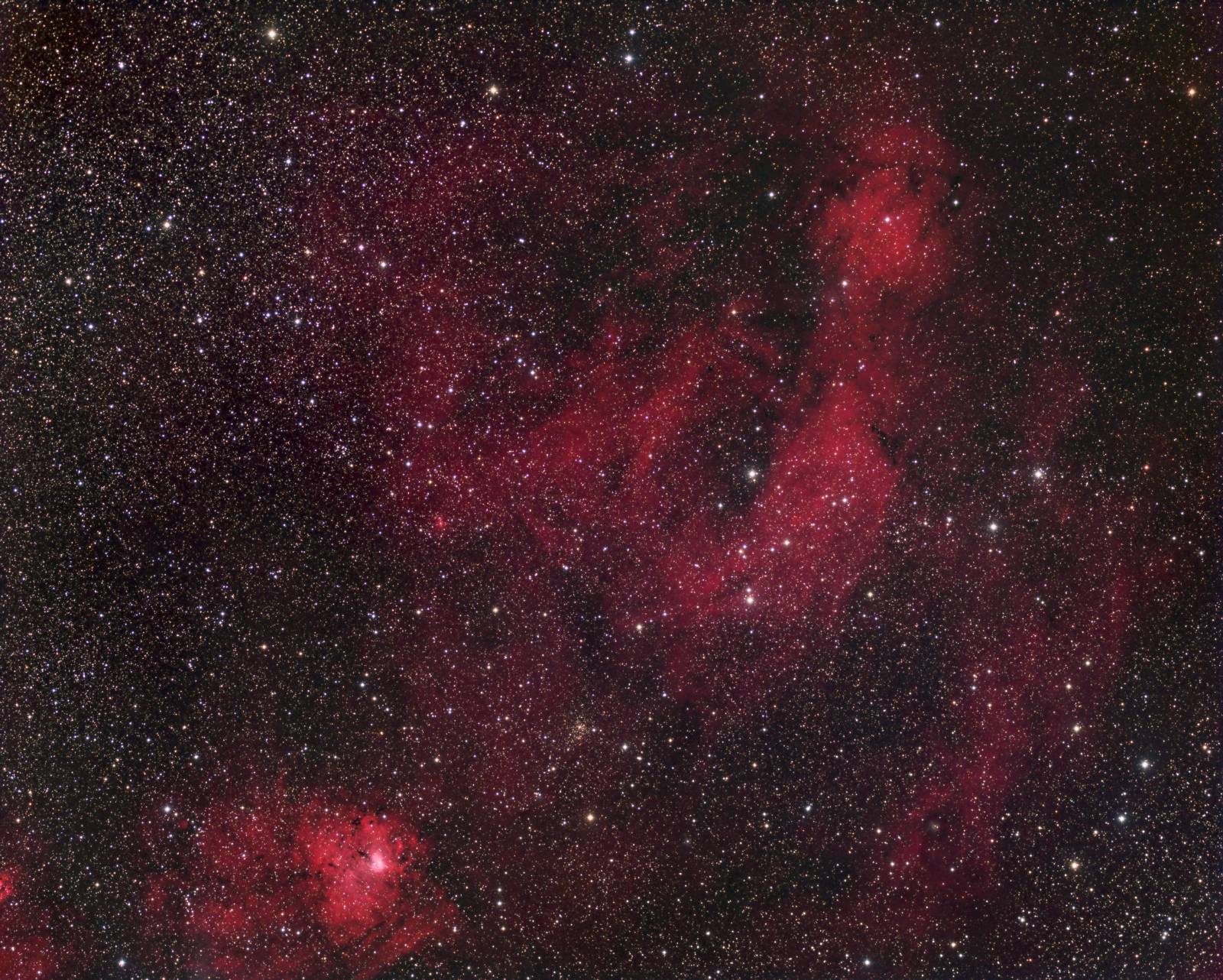Sh2-205 and NGC 1491
 Click image for full size version
Click image for full size version
March 12, 2018
This wide-field image shows large Sh2-205 dominating the centre and upper right, and NGC 1491 (aka Sh2-206) at lower left. Between them is pretty open cluster King 7. See the annotated image for a few other objects in the image. This field lies on the border of Perseus and Camelopardalis, and both nebulae are about 3,000 light years from us. I like the bright details in the core of NGC1491, and the dark details throughout the image.
King 7 is very colourful, containing many gold-coloured stars arranged in a triangle shape. It lies behind the nebulae, at about 8,500 light years.
Tekkies:
Moravian G3-16200 EC camera (on loan from O’Telescope), Optolong Ha, R, G and B filters, Takahashi FSQ-106 ED IV at f/3.6, Paramount MX. QHY5 guide camera on 175mm guide scope. Acquisition with the SkyX, focused with FocusMax, scripted with CCD Commander. All pre-processing and processing in PixInsight. Acquired from my SkyShed in Guelph. Moderate to severe moonlight for Ha, no moonlight for RGB, average transparency and seeing.
21x10m R, 17x10m G, 17x10m B and 62x10m Ha unbinned frames (total=19hr30m).
RGB:
Creation and cleanup: The BatchPreProcessing script was used to perform calibration, cosmetic correction and registration of all frames. LocalNormalization was applied, and ImageIntegration and DrizzleIntegration were used to make the Ha, R, G and B masters, using Local Normalization for scaling. The R, G, B masters were processed with DynamicBackgroundExtraction. The R, G and B masters were combined to make an RGB image which was processed with PhotometricColorCalibration.
Linear Noise Reduction: MultiscaleLinearTransform was used to reduce noise in the RGB image. Layer settings for threshold and strength: Layer 1: 3.0 0.8 Layer 2: 2.5, 0.7 Layer 3: 2., 0.6 Layer 4: 1.0, 0.2 Layer 5: 0.5, 0.1.
Stretching: Two low-strength passes of ArcsinhStretch were used to slightly stretch the image, setting the black point so as to avoid any clipping. HistogramTransformation was applied to make a pleasing, bright image. Curve was applied to boost contrast and saturation.
Synthetic Luminance:
Creation and cleanup of SynthL: The R, G and B channel masters were integrated (average, noise weighted, no rejection) using ImageIntegration to create the SynthL.
Deconvolution: A star mask was made to use as a Local Deringing Support image. A copy of the image was stretched to use as a range mask. Deconvolution was applied (50 iterations, regularized Richardson-Lucy, external PSF made using DynamicPSF tool with about 30 stars).
Linear Noise Reduction: MultiscaleLinearTransform was used to reduce noise in the background areas of the SynthL. Layer settings for threshold and strength: Layer 1: 3.0 0.9 Layer 2: 2.0, 0.75 Layer 3: 1.0, 0.6 Layer 4: 0.5, 0.2.
Stretching: HistogramTransformation was applied to the SynthL to make a pleasing, bright image.
Noise Reduction and Re-Stretch: TGVDenoise was applied in Lab mode with 300 iterations with a range mask applied to protect high signal areas. This was followed by a HistogramTransformation to raise the black point (but with no clipping).
H-alpha:
Deconvolution: A star mask was made to use as a Local Deringing Support image. A copy of the image was stretched to use as a range mask. Deconvolution was applied (50 iterations, regularized Richardson-Lucy, external PSF made using DynamicPSF tool with about 20 stars).
Linear Noise Reduction: MultiscaleLinearTransform was used to reduce noise in the background areas of the Ha image. Layer settings for threshold and strength: Layer 1: 3.0 0.9 Layer 2: 2.0, 0.75 Layer 3: 1.0, 0.6 Layer 4: 0.5, 0.2.
Stretching: HistogramTransformation was applied to the Ha to make a pleasing, bright image.
Noise Reduction and Re-Stretch: TGVDenoise was applied in Lab mode with 300 iterations with a range mask applied to protect high signal areas. This was followed by a HistogramTransformation to raise the black point (but with no clipping).
Combining SynthL, RGB and Ha:
SynthLRGB: The processed SynthL was applied to the RGB image using LRGBCombine.
SynthLHaRGB: Two images were made and then blended. First the NBRGBCombination script was used to add Ha to the red channel. Then PixelMath was used to add 50% Ha to the red channel and 5% Ha to the blue using a mask to protect stars and background areas free of nebulosity (identified based on the Ha image). The two images were blended 1:1.
Additional Processing:
Shrinking the Stars: MorphologicalTransformation was used in Morphological Selection mode (Selection 0.13, strength 0.12) with a star mask to slightly reduce the size of the stars.
Dark Structures: The DarkStructureEnhance script was used (8 layers, strength 0.2) to darken dark regions in IC 410.
Sharpening: Using a mask throughout sharpening, MultiscaleLinearTransform was applied to sharpen layers 2 and 3 (bias of 0.2 and 0.1, respectively)
Final Steps: Background, nebula and star brightness, contrast and saturation were adjusted in several iterations using Curves with masks as required. A few dark pixels in the darkest parts of the image were brightened slightly using PixelMath The image was downsampled by a factor of 2 using IntegerResample to restore the original resolution.
Image scale is about 3.2 arcsec per pixel for this camera/telescope combination.






Always a pleasure seeing your images